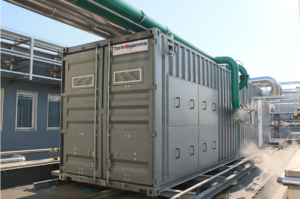Cogeneration for industrial applications
Introduction:
The concept of cogeneration, as the word itself suggests, alludes to the production of electrical and thermal energy simultaneously thanks to a primary fossil resource of various types.
It is also known by the English acronym CHP – Combined Heat and Power (Combination of Heat and Power).
A cogeneration plant needs a primary resource that feeds the system itself; this resource can be natural gas, biomass, biogas, biomethane, and LNG.
Cogeneration technology is constantly evolving, and in fact, some systems use hydrogen as the primary source of power for the plant.
Operation:
Cogeneration plants can operate mainly through two distinct cycles: the Brayton-Joule cycle and the Otto cycle.
The former refers to cogeneration plants that have a high-pressure gas turbine inside, the latter refers to a cogenerator with a classic internal combustion engine powered by the right energy carrier.
The energy released by the gas fed into the engine generates a certain amount of mechanical energy, which, through the appropriate “alternator” is transformed into electricity. The electrical energy efficiency of these types of motors is in a range ranging from about 35 to 40% (the correlation also depends on the size of the motor in question, generally the bigger the machine the more efficiency will be obtained).
To achieve the overall energy efficiency of the system greater than a simple plant for the production of electricity each cogenerator is correlated with several heat exchangers usually designed to recover heat, otherwise lost, by exhaust fumes and by the body of the engine itself.
This thermal recovery process allows the plant to obtain low-temperature heat (up to 90 degrees centigrade) to be distributed to users or industrial processes that need it. Thanks to these measures and the use of very high-efficiency heat exchangers, the overall system achieves a global efficiency that is confirmed between 80 and 90%. It also curbs CO2 emissions compared to traditional thermal power plants for the production of energy that usually waste in the environment about 60% of their primary energy.
Why Termogamma is available:
Because Termogamma is a true tailor of energy solutions, a company that puts forward people and the care of the empathic aspect of every relationship to the mere sale. In 35 years of development it has always highlighted and tried to develop to a greater extent the phases that distinguish it from other players in the industry, such as listening to the real needs of the customer, total flexibility on the solutions offered and maintenance service designed to generate long-lasting relationships based on trust.
Due to the company’s size Termogamma can truly follow the customer through his doubts, offering in conclusion a unique solution and designed specifically for its industrial reality.
Termogamma takes care of every aspect and stage of the journey that a customer takes after the desire to embrace a green policy. It therefore ranges from the genesis of the intentional idea of installing a cogeneration plant to the treatment of the latter until the death of the cogeneration solution.


